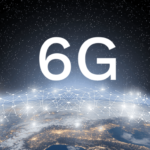
(Source – Shutterstock)
6G technology momentum increases in the Asia Pacific
As the world continues to embrace 5G technology, some countries and organizations have already set their sight on 6G technology. The next generation of mobile connectivity is still about a decade away before being implemented but the innovation in the technology continues to gain traction.
According to reports, 6G will require dramatic advances in communications technology to achieve 10 to 100 times higher speeds and capacities than 5G, with an ultra-low power consumption of 1/100 and coverage that reaches from the depths of the ocean to the heights of outer space.
In the Asia Pacific, several tech companies, universities, and research institutes are already working towards developing real-world use cases with 6G technology as well as studying how the technology can reshape connectivity in the world in the future.
For example, in Singapore, Keysight Technologies’ software-centric test and measurement solutions to advance 6G technology based on terahertz frequencies have been selected by the Centre for Disruptive Photonic Technologies. The center chose Keysight’s solutions to validate on-chip terahertz electronic-photonic devices such as transceivers.
Located at Nanyang Technological University, Singapore (NTU Singapore), the center leverages terahertz frequencies to develop a unique electronic-photonic hybrid approach. It can be used to design mobile devices capable of efficiently operating at data rates of up to several terabits per second (Tbps). Many emerging applications and future 6G use cases, including augmented reality, holographic communication, and mobile edge computing rely on such high data rate speeds.
According to Boon Juan Tan, vice president, and general manager of Keysight’s general electronics measurements solutions (GEMS) group, Keysight is pleased to contribute to breakthroughs in 6G technology by providing NTU with a 6G testbed that accurately analyzes unchartered terrain spanning electronics and photonics technologies for their TeraX Lab.
Keysight’s integrated software and hardware tools, with advanced performance in measurement science applicable to 6G technology, enable NTU to accurately characterize complex transceiver modules. Keysight combines the company’s high-speed arbitrary waveform generator (AWG), optical modulation analyzer with highly detectable symbol rates, network analyzer (PNA), PSG analog signal generator with compact upconverters and downconverters from Virginia Diodes Inc. (VDI) and PathWave Vector Signal Analysis software to create a turnkey solution for comprehensive testing and validation of on-chip terahertz electronic-photonic devices.
From Singapore to Japan, innovation continues in 6G technology
Meanwhile, in Japan, NEC is collaborating with NTT DOCOMO, INC. (DOCOMO), and NTT on 6G experimental trials. NEC will work with DOCOMO and NTT on a distributed MIMO technology for utilizing the mid-band of 6GHz or higher to the sub-terahertz band, and OAM multiplex transmission technology that realizes large capacity by spatial multiplexing of high-frequency band radio waves.
NEC will also conduct R&D on device technologies for reducing the size and power consumption, as well as high-precision beamforming technologies, transmission methods, and propagation models suitable for high-frequency bands. This is in addition to the development of optimization and signal processing technologies utilizing AI. NEC aims to develop and realize these technologies for supporting the start of 6G services by DOCOMO and NTT near 2030.
For NEC, 6G technology is not only a dramatic evolution in radio technology, but also a social infrastructure that combines the use of optical communications, operational sophistication through IOWN, a concept for realizing new smart societies that are not yet possible with today’s internet, and service/application infrastructure such as distributed computing and AI. Through activities with DOCOMO and NTT, NEC will accelerate the R&D of communications technologies for 6G and work to create social value by realizing 6G services.
Naoki Tani, Executive Vice President, and Chief Technology Officer at DOCOMO commented, “NEC and DOCOMO have been collaborating since 2014 to verify wireless technologies and create new use cases for the commercial launch of 5G. We are delighted to collaborate with NEC as a partner in these trials of 6G technology. DOCOMO and NTT will now start verification of technologies that enable stable communication in new frequency bands, such as sub-terahertz bands, realize large capacity and contribute to 6G commercialization with vertical industry partners.”
DOCOMO and NTT are also partnering Nokia to jointly define and develop key technologies towards 6G. The collaboration will focus on demonstrating two proof-of-concepts for emerging 6G technologies: the benefits of AI-based learned waveform in the transmitter with a deep learning receiver in the mid-band, as well as to test high data rate indoor communications in the sub-THz band.
Both Nokia and DOCOMO have a long history of pioneering research that brings new wireless technologies to life. With this announcement, Nokia, DOCOMO and NTT will continue to shape next generation technologies together. The plan is to set up environments for experiments and demonstrations in DOCOMO and NTT premises in Japan and Nokia premises in Stuttgart, Germany, and to begin performing the desired tests and measurements in 2022.
Tani explained that DOCOMO and NTT will now start the experimental trials of two 6G proof-of-concepts with Nokia for high-rate transmission in the sub-THz band and AI native air interface, and contribute to 6G commercialization with vertical industry partners.
Apart from Singapore and Japan, other countries in the Asia Pacific are also in R&D stages of 6G technology. This includes China, Vietnam and India, even though subcontinent has yet to launch 5G yet.
READ MORE
- Strategies for Democratizing GenAI
- The criticality of endpoint management in cybersecurity and operations
- Ethical AI: The renewed importance of safeguarding data and customer privacy in Generative AI applications
- How Japan balances AI-driven opportunities with cybersecurity needs
- Deploying SASE: Benchmarking your approach


